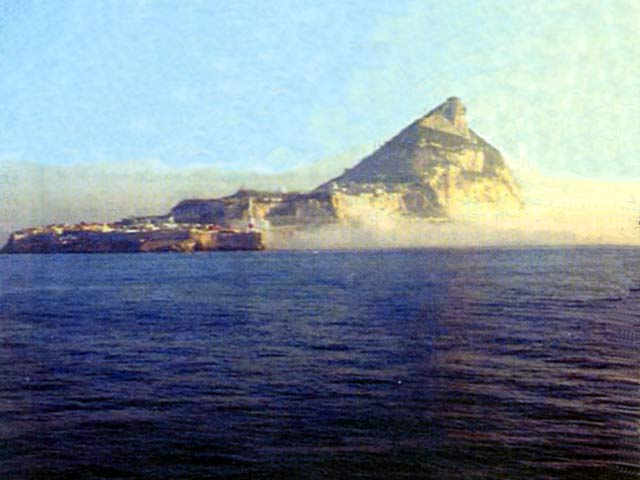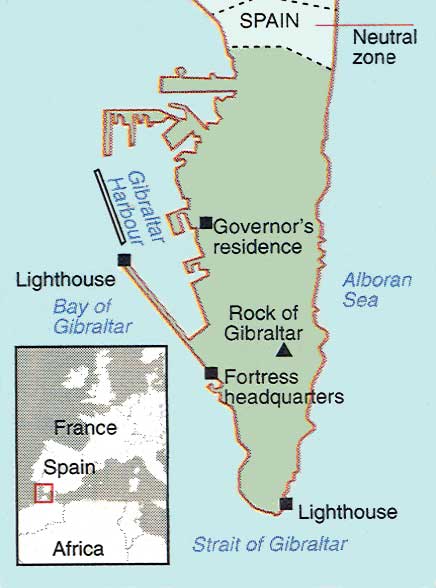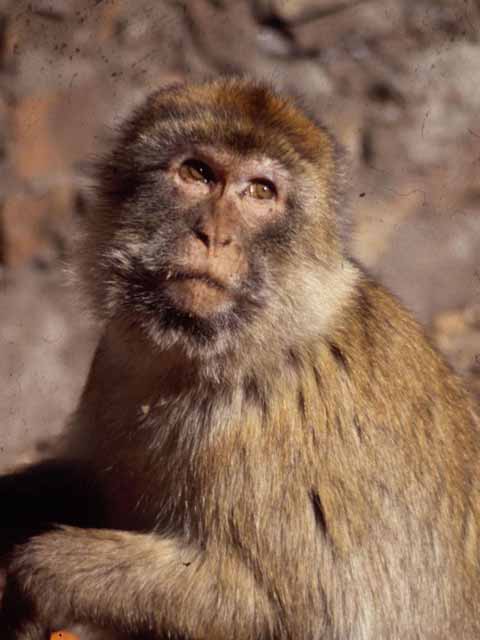The Rock of Gibraltar
Pillar of HerculesAs a rock on the seashore he standeth firm, and the dashing of the waves disturbeth him not. - Aristotle
The Rock of Gibraltar Exploring the Rockby Jean Allen It's one of the world's most familiar landmarks: a huge limestone rock towering above the fringe of buildings, people and traffic around it, facing a narrow expanse of water that separates Europe from Africa. Like most visitors to the British enclave of Gibraltar, I saw it on a day trip from nearby Spain. That's enough time to see the Barbary apes, ascend The Rock by cable car, shop at Marks & Spencer and other very British shops along Main St, have a pub lunch, explore a big cave where Neanderthals once lived, gaze across the Strait of Gibraltar at Africa, 24 kilometres away, and explore narrow congested streets looking at an odd collection of Georgian, Victorian, Italian and Moorish architecture. We start out in the morning in Ronda, Spain, and ride along zigzagging mountain roads high above the Mediterranean Sea, past picturesque "white villages" in rocky hills brightened by stands of yellow broom. At the border town of La Linea, we leave our big bus, which cannot navigate the colony's winding, hilly streets, and board a smaller one to see Gibraltar's 10.35 square kilometres. The place is so compact that, to reach town, we have to drive across the airport runway. The Rock is the place to spend the most time on a day trip. This mini-mountain, 6.5km long, 800 metres wide and 417m high, is one of the ancient Pillars of Hercules that marked the end of the known world; the other pillar is a mountain across the strait in Morocco. In myth, Hercules straddled the strait, one foot on each continent. Heading for the sloping road up The Rock, we stop at Europa Point, Gibraltar's southern tip, to visit the lighthouse and see a mosque built with private funds to salute the Arabs of the Gulf War. From Europa Point, and from viewing points on the mountain, we can see dolphins cavorting in the strait; dolphin and whale-watching cruises are available. The Bay of Algeciras is a beautiful sight, and Algeciras to the west is a busy container-cargo port. Our guide, Henry, tells us the strait is a channel 58km long that connects the Atlantic Ocean and the Mediterranean Sea.
The Rock, Gibraltar's most popular sightseeing spot. It is home to the Barbary apes, tail-less, cinnamoncoloured macaques, Halfway up The Rock, Ape's Den at Queen's Gate is the best place to view Gibraltar's Barbary apes. These tail-less, cinnamon-coloured macaques are native to Morocco's Atlas mountains and were brought here by the British in the 18th century. About 160 of them live in Gibraltar. We stop to visit Europe's only wild apes, who tease and tolerate visitors, hoping for handouts. Brash and bold, they take treats from our hands and allow us to take their pictures. Visitors are cautioned not to touch them; they may bite if frightened or annoyed. They are free to roam, and the bigger of two packs stays on the mountain's upper cliffs while a smaller pack is at Ape's Den. The rock is full of tunnels and caves. Military sieges of the late 18th century led to the excavation of a honeycomb of more than 50km of tunnels, and some sections can be visited by prior arrangement. Most visitors settle for a visit to St Michael's Cave, an immense cavern with the huge main chamber called Cathedral Cave used as an auditorium for concerts. During the American Revolution, France and Spain decided that while the British were distracted by the colonists' rebellion, they could take back Gibraltar. They mounted a siege that lasted from 1779 to early 1783. But the tunnels enabled the British to move cannons to points on the mountain's steep face. Some of the cannons are still there. The fastest way to the summit is a 6-minute cable car ride from the station in the Grand Parade at the end of downtown's Main St. After descending from The Rock, we schmooze in the downtown pedestrian zone filled with shoppers and people snacking at pubs or sidewalk cafes. British pounds and Spanish pesetas are accepted as currency. The 30,000 residents speak English, Spanish or a blend that our guide calls Spanglish. Gibraltar is a pint-size melting pot, a mix of English, Moorish, Genoese, Portuguese, Spanish, Jewish, Maltese and Indian. It has been a British territory since the early 18th century. The Battle of Trafalgar was fought near The Rock in 1805, it was home to an Allied Naval fleet in World War II, and a focal point for the invasion of North Africa. The border was closed for 13 years beginning in 1969 as Spain's dictator Franco tried to regain The Rock. Today, its borders open, visitors can arrive on a flight from England, by ferry from Tangier, Morocco or by road. Those who want to stay a while will find good beaches, bird-watching, a gambling casino, plenty of restaurants and museums. - KRT
Source: www.nasa.gov Fact FileGetting there: The bus station at La Linea in Spain is only 5 minutes from the border. Buses do not run on Sundays, so you must walk the 1.5kms from the border,
across the airport runway, into town. Source: The Dominion Tuesday 3 April 2001
Mystery of Churchill's WWII Monkeys Solved
A Gibraltar macaque by Robert Roy Britt If you've ever been to Gibraltar, the Mediterranean rock run by the British, you know about the monkeys. Some 200 of them run wild on the tiny peninsula, and they're the only free-ranging monkeys in Europe. They love to climb on tourists' heads and will gladly accept a snack. What you didn't know is where they came from. Scientists haven't even known for sure. Gibraltar, a tiny British territory jutting out from southern Spain, sits at the strategically crucial pinched entrance to the Mediterranean. During World War II, there were as few as 3 macaques left on the rocky outpost, historians say. There was a legend back then that Britain would lose the territory if the monkeys died out. So in 1942, Prime Minister Winston Churchill ordered their numbers be replenished. Details were kept secret. Many scientists suspected the imported macaques came from Morocco. Some thought they might also have come from Algeria. In a new study, researchers analyzed the monkey's DNA to learn that they are descended from macaques in both Morocco and Algeria. The isolation of the Gibraltar monkeys since the war mimics a phenomenon in nature caused by forest clearing and other pressures. "The Gibraltar colony of Barbary macaques provided an ideal example of genetic isolation of a small population, which is now a regular occurrence among wild primate populations because of forest fragmentation," said Robert Martin, a primatologist and Field Museum Provost. "To our surprise, we found a relatively high level of genetic variability in the Gibraltar macaques. This is now explained by our conclusion that the population was founded with individuals from two genetically distinct populations in Algeria and Morocco." That still leaves a mystery of where the original Gibraltar macaques came from. Some scientists think they were brought by the Moors, who occupied Spain between 711 and 1492. Others figure they were a remnant of macaques that lived throughout Southern Europe 5.5 million years ago and possibly, some speculate, as recently as the 1800s in Spain. The research was detailed Monday in the early edition of the Proceedings of the National Academy of Sciences. Robert Roy Britt is a senior writer for LiveScience.com Source: livescience.com 25 April 2005 photo credit Robert Martin, the Field Museum
For more articles relating to Money, Politics and Law including globalisation, tax avoidance, consumerism, credit cards, spending, contracts, trust, stocks, fraud, eugenics and
more click the "Up" button below to take you to the page on "How Many Countries in the World?" Clicking "Up" from there will take you to the Index for this section. |
 Animals
Animals Animation
Animation Art of Playing Cards
Art of Playing Cards Drugs
Drugs Education
Education Environment
Environment Flying
Flying History
History Humour
Humour Immigration
Immigration Info/Tech
Info/Tech Intellectual/Entertaining
Intellectual/Entertaining Lifestyles
Lifestyles Men
Men Money/Politics/Law
Money/Politics/Law New Jersey
New Jersey Odds and Oddities
Odds and Oddities Older & Under
Older & Under Photography
Photography Prisons
Prisons Relationships
Relationships Science
Science Social/Cultural
Social/Cultural Terrorism
Terrorism Wellington
Wellington Working
Working Zero Return Investment
Zero Return Investment



